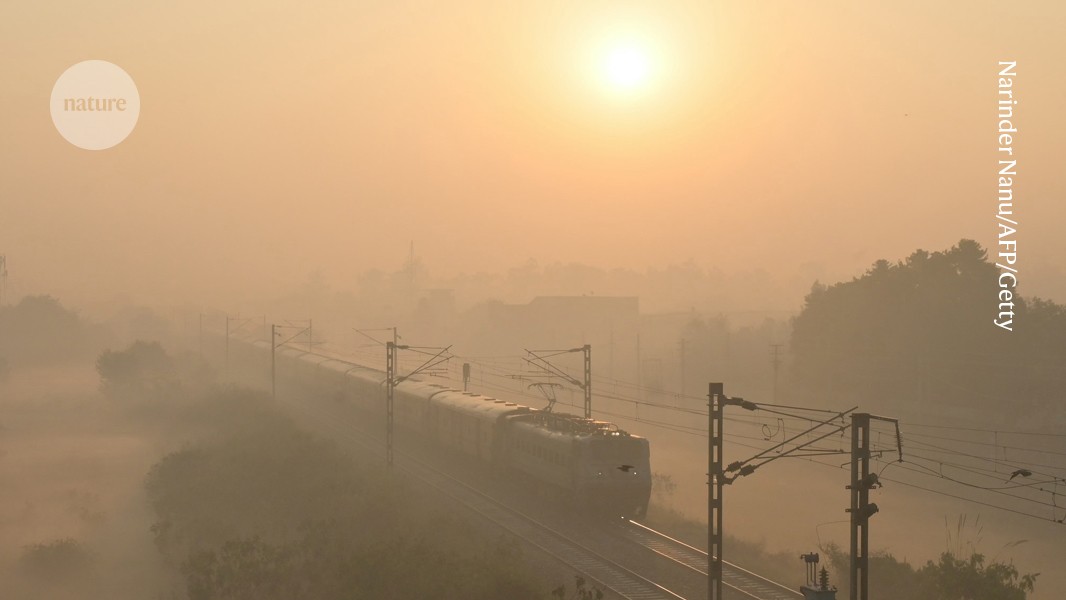A thaw in scientific relations could help clear the air in India and Pakistan

The annual toxic smog that forms over swathes of India and Pakistan is preventable, but the nations’ scientists have too little opportunity to help tackle the problem

A train cuts through winter smog in Amritsar, India.Credit: Narinder Nanu/AFP/Getty
A toxic haze has descended over a land area shared by some 500 million people in the northern parts of India and Pakistan. Its sources include the industrial emissions, domestic fires and diesel and petrol exhausts that form the largest components of air pollution in many parts of the world. But during winter in South Asia, crop residue burning is estimated to be the biggest source. It is an annual event that massively worsens the region’s atmospheric concentrations of fine particulate matter — that measuring 2.5 micrometres or less in diameter. These concentrations already exceed the safe limit advised by the World Health Organization. Air pollution is a leading cause of child death and is devastating for the communities that have to endure it. It also contains climate-altering compounds.
In Nature this week, researchers show how the field of computational social science, along with publicly available data, could help authorities in India and Pakistan begin to address a problem that affects both nations (G. Dipoppa & S. Gulzar Nature 634, 1125–1131; 2024). The work also highlights what could be achieved if scientific links between the two countries were not frozen as a result of worsening relations between their governments. An overdue thaw could save lives and improve health in both nations.
The annual winter burning of crop waste in South Asia has its roots in earlier science. High-yielding crop varieties born of 1960s-era green-revolution technologies, combined with mechanization, have enabled farmers in the nations’ agricultural heartlands to grow wheat and rice on the same fields in the same year. Once a rice crop has been harvested, farmers burn millions of tonnes of leftover materials, clearing the land for the wheat-planting season. The resulting haze cuts visibility to a few metres, shuts schools, impedes road transport and causes flights to be cancelled.
Researchers are actively studying both the extent of the pollution and prevention strategies. Gemma Dipoppa at Brown University in Providence, Rhode Island, and Saad Gulzar at Princeton University in New Jersey have examined the authorities’ responses to the fires in India and Pakistan over a ten-year period, from 2012 to 2022. The authors compared fire, air pollution and wind-speed data with police and court records of action taken against farmers. They also studied the effects of the pollution on health. Burning crop waste is against the law in both countries and violations can lead to farmers being fined or even imprisoned. But many are willing to take that risk. And the sheer number of farmers lighting fires at the same time makes it unfeasible for the authorities to deal with them all.
The authors found that officials in both countries are more likely to take action against farmers if winds are blowing pollution across home turf, and that crop residue burning decreases as a result. They also found that this effect is larger in areas close to the border between the two countries — in other words, farmers in both nations are more likely to be penalized for crop residue burning if the wind is blowing towards their own side. This raises questions that would benefit from further enquiry. For example, to what extent might India’s and Pakistan’s authorities be cancelling out each other’s pollution-control efforts close to the border? And on days when one country is putting resources into dealing with high levels of pollution within its own borders, is it also receiving more pollution from its neighbour?
Further research — both analyses of remote data and field-based studies — will help researchers to understand the perspectives of farmers and the factors underlying the actions of government officials.
Efforts to answer these and other questions would benefit from greater collaboration. However, at present, there are minimal links between researchers in India and Pakistan. Non-governmental links (sometimes called track-two diplomacy), including scientific connections, are the weakest they have been in around a decade. Scientists used to be able to meet through the eight-country South Asian Association for Regional Cooperation (SAARC), based in Kathmandu, but SAARC has not been functioning, mainly because of the continuing tensions between India and Pakistan. The agricultural scientists’ committee has not met in five years. There’s a strong case for such links to be revived.
So much could be gained if researchers in the two nations could communicate better, work together and study each other’s situation. Dipoppa and Gulzar’s work illustrates what can be achieved with open data, and why science should not be done solely within national borders. When it comes to addressing problems with a regional or global dimension — and when people’s lives and health are at stake — policymakers must prioritize collaboration.
Nature 634, 1018 (2024)
doi: https://doi.org/10.1038/d41586-024-03485-0
This story originally appeared on: Nature - Author:furtherReadingSection


















